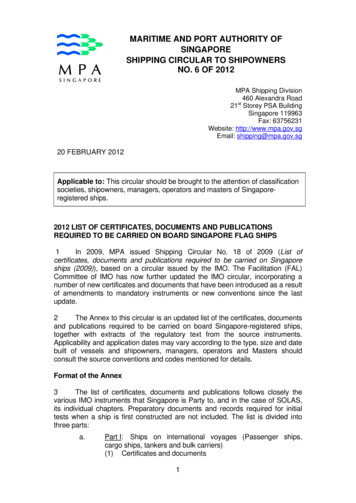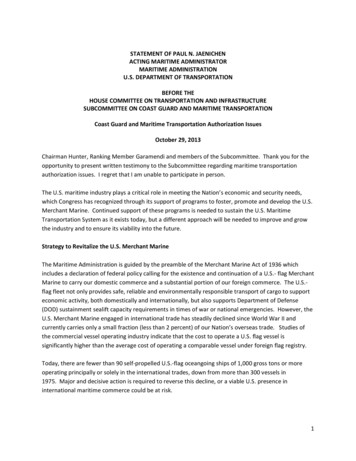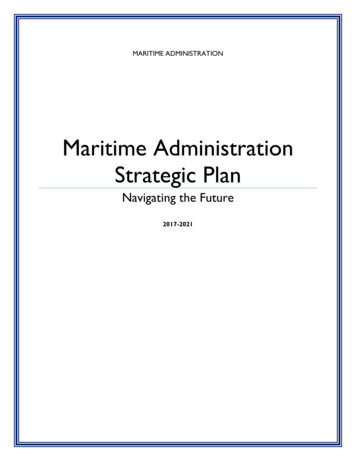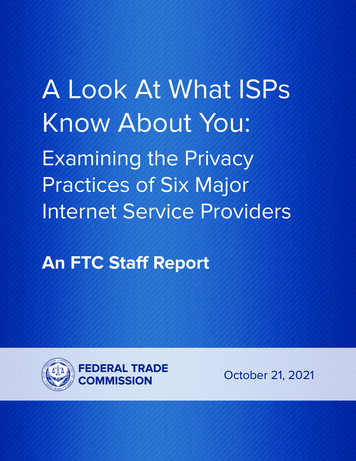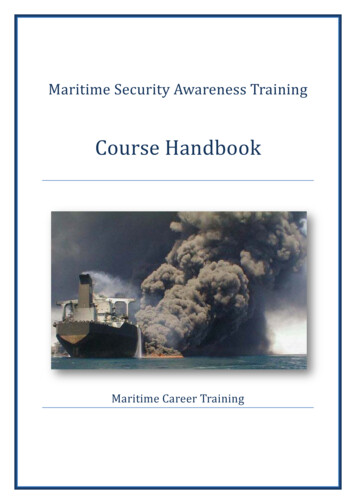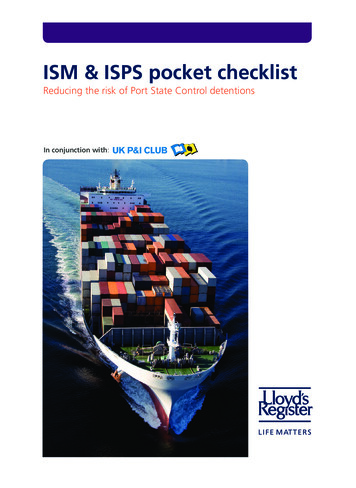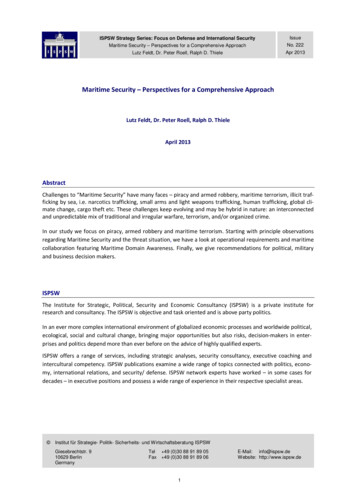
Transcription
717[LEGAL NOTICE No. 102]MARITIME TRANSPORT DECREE 20 I 3(DECREE No. 20 OF 2013)Maritime (ISPS Code) Regulations 2014TABLE OF PROVISIONSI.2.3.4.PART I - PRELIMINARYShort title and commencementPurposeInterpretationApplicationPART 2-RESPONSIBILITY OF THE AUTHORITY5.6.7.8.Certificate of ComplianceOffences and penaltiesResponsibilities of the AuthorityDeclaration of SecurityPART 3-RESPONSIBILITY OF SHIPPING COMPANIES AND SHIPS9.10.I I.12.13.14.15.16.17.18.Obligation of the CompanyShip SecurityMaster's discretionShip Security AssessmentShip Security PlanRecords and auditsAuditsCompany Security OfficerShip Security OfficerTraining Drills and Exercise on ship securityPART 4- REQUIREMENTS FOR RECOGNISED SECURITY ORGANISATION19.Recognised Security OrganisationPART 5-REQUIREMENTS FOR PORT FACILITIES20.21.22.23.24.25.26.27.Port facility securityPort facility security assessmentPort facility security planPort facility security officerPort security conunitteeSecurity personnelTraining, drill, exercises on port facility securityRecords, audits, review and amendmentsPART 6-CERTIFICATION OF SHIPS28.29.Verification and certification for shipsIssue or endorsement of certificate
71830.31.Duration and validity of certificateInterim certificationPART 7 -MISCELLANEOUS32.RepealSCHEDULESSchedule 1 International Ship Security CertificateSchedule 2- Interim International Ship Security CertificateSchedule 3 - Declaration of SecuritySchedule 4-Statemcnt of Compliance of a Port FacilitySchedule 5-0ffences and PenaltiesSchedule 6- Fees and ChargesIN exercise of the powers conferred upon me by section 240( 1)(x) of the Maritime TranspOltDecree 2013, I hereby make these RegulationsPART I - PRELIMINARYShorl tille (llId cOll/mencementI. These Regulations may be cited as the Maritime (ISPS Code) Regulations 2014and shall come into force on 1st JanuaJ)l, 2015.Purpose2.-( 1) The objective of these Regulations is to establish a national framework amongstgovernment agencies, the Authority and the shipping and port industry to detect, accessand take preventative measures against security threats or incidents affecting ships or portfacilities in Fiji used in international trade.(2) These Rcgulations(a)establish the respective roles and responsibilities of all parties concernedfor ensuring maritime security, and the early and efficient collation andexchange of security related information; and(b)provide the methodology for security assessments for plans and proceduresto counter changing security levels in Fiji.interpretation3. (l)In these Regulations, unless the context otherwise requires,-"Authority" means the Maritime Safety Authority of Fiji;"Administration" means the government of the State whose Flag the ship isentitled to fly;"Chief Executive Officer" means the Chief Executive Officer of the Authorityunless expressly provided otherwise in these Regulations;"Chapter" means a chapter of the Convention;"Company" means the owner of the ship or any other organisation or person suchas the manager, or the bareboat chat1erer, who has assumed the responsibility
719for operation of the ship from the ship owner and who, on assuming slIchresponsibility, has agreed to take over all duties and responsibility imposedby these Regulations and the Code;"CSO" means the Company Security Officer designated by the Companyfor ensuring that a ship security assessment is can-jed out; that a SSP isdeveloped, submitted for approval, and thereafter implemented andmaintained and for liaison with PFSOs and the SSO;"Convention" means the International Convention for the Safety of Life at Sea,1974 as amended;"Code" means the International Ship and Port Facility Security Code, andincludes amendments made to it from time to time;"Decree" means the Maritime Transport Decree 2013;"Declaration of Security" means an agreement reached between a ship andeither a port facility or another ship with which it intelfaces specifying thesecurity measures each will implement;"Mobile offshore drilling unit" means a mechanically propelled mobile offshoredrilling unit, as defined in Chapter IXiI of the Convention;"Port Facility" means a location, as determined by the Authority, where ship/portinterface takes place, and this includes areas such as anchorage, waitingberths and approaches from seaward;"PFSO" means the Port Facility Security Officer designated as responsible forthe development, implementation, revision and maintenance of the PFSPand for liaison with the SSOs and CSOs;"PFSP" means the Port Facility Security Plan developed to ensure the applicationof measures designed to protect the port facility and ships, persons, cargo,cargo transport units and ship's stores within the port facility from the risksof a security incident;URSa" means a Recognised Security Organisation with appropriate expertise insecurity matters and with appropriate knowledge of ship and port operationsauthorised to carry out an assessment, or a verification, or approval orcertification activity required by these Regulations and the Code;"Security incident" means any sllspiciolls act or circulllstance threatening thesecurity of a ship, including a mobile offshore drilling unit and a high speedcraft, or of a port facility or of any ship/port interface or any ship to shipactivity;"Security level" means the qualification of the degree of risk that a securityincident will be attempted or will occur;"Security level 1n (Normal) means the level at which the ship or port facilitynormally operates with minimum appropriate protective security measures;
720"Security level 2" (Heightened) means the level applying for as long as there isa heightened risk of a security incident for which appropriate additionalprotective security measures shall be maintained;"Security level 3" (Exceptional) the level applying for the period of time whenthere is the probable or imminent risk of a security incident for whichfurther specific protective security measures shall be maintained;"SSO" means the Ship Security Officer on board the ship, accountable to themaster l designated by the Company as responsible for the security of theship, including implementation and maintenance of the SSP and for liaisonwith the CSO and PFSOs;"SSP" means the Ship Security Plan developed to ensure the application ofmeasures on board the ship designed to protect persons on board, cargo,cargo transport units, ship's stores or the ship from the risks of a securityincident;"Ship to Ship activity ! means any activity not related to a port facility thatinvolves the transfer of goods or persons from one ship to another;"Ship to Port Interface" means the physical, operational, or notional location inwhich ships and supporting watercraft engage port facility services.(2) The term "ship", when used in these Regulations and the Code, includes mobileoffshore drilling units and high-speed craft as defined in Chapter XI-21l.(3) The term "Contracting Government" in connection with any reference to a portfacility, when used in these Regulations, includes a reference to the "Administration".(4) Terms not otherwise defined in these Regulations shall have the same meaning asthe meaning attributed to them in Chapters I and XI-2.Application4.-(1) These Regulations apply 10(a)(b)the following types of ships engaged in international voyages(i)passenger ships, including high-speed passenger craft;(ii)cargo ships, including high-speed craft, of 100 gross tonnage andupwards;(iii)Fiji ships engaged in international voyages, any ships returningfrom the high seas and foreign flagged ships in Fiji waters orintending to proceed to a port or facility in Fiji that is subject tothese Regulations;(iv)mobile offshore drilling units; andport facilities serving such ships engaged in international voyages.(2) These Regulations do not apply to warships, naval auxiliaries or other ships ownedor operated by a Contracting Government and used only on Government non-commercialservice.
721(3) Notwithstanding sub-regulation (I), the Authority shall decide the extent ofapplication of these Regulations to port facilities within Fiji which, although used primarilyby ships not engaged in international voyages, which arc also required, occasionally, toserve ships arriving or departing on an international voyage.(4) The Authority shall base its decision, on a port facility security assessment carriedout in accordance with these Regulations.(5) Any decision which the Authority makes shall not compromise the level of securityintended to be achieved by Chapter XI-2 as amended or by these Regulations.(6) Regulations 8 to 18 and 28 to 31 shall apply to companies and ships as specifiedin Chapter XI-214.(7) Regulations 8 and 20 to 27 shall apply to port facilities as specified in ChapterXI-2/l0.(8) Nothing in these Regulations shall prejudice the rights or obligations of the Republicof Fiji under international law.PART 2-REPONSIBILITY OF THE AUTHORITYCertificate oj Compliance5.-( I) The Authority may, upon application and after assessing and verifying a ship,port or port facility under Article 3 of the Code, issue a cCl1ificate of compliance to the shipor port or port facility as prescribed in the Code.(2) The applicant for a certificate of compliance shall pay the fees to the Authority asprescribed in Schedule 2.Offences olld pellolties6.-(1) Any person or owner, operator or agent of a ship, or POlt or port facility towhich the Code applies, that contravenes a provision of these Regulations commits anoffence and is liable upon conviction to a fine not exceeding 100,000 or imprisonmentfor a term not exceeding 10 years or to both.(2) Offences and penalties under these Regulations are prescribed in Schedule 5.Responsibilities o/Ihe Authority7.-(1) Subject to the provisions of Chapters XI-213 and XI-217, the Authority shallset security levels and provide guidance for protection from security incidents.(2) Higher security levels indicate greater likelihood of occurrence of a security incidentand factors to be considered in setting the appropriate security level include (aJthe degree that the threat information is credible;(bJthe degree that the threat information is corroborated;(c)the degree that the threat information is specific or imminent; and(d)the potential consequences of such a security incident.
722(3) The Authority, when setting security level 3, shall issue, as necessary, appropriateinstructions and shall provide security related information to the ships and port facilitiesthat may be affected.(4) The Authority may delegate to a RSO certain responsibilities under Chapter XI-2and these Regulations with the exception of-la)setting of the applicable security level;( b)approving a Port Facility Security Assessment and subsequent amendmentsto an approved assessment;Ie)determining the port facilities which will be required to designate a PFSO;Id)approving a PFSP and subsequent amendments to an approved plan;(e)exercising control and compliance measures pursuant to Chapter XI-2/9;and(I)establishing the requirements for a Declaration of Security.(5) The Authority shall, to the extent it considers appropriate, test the effectiveness ofthe Ship or the Port Facility Security Plans, or of amendments to such plans, it has approved,or, in the case of ships, of ships security plans which have been approved on its behalf.Declaration o/Security8.-(1) The Authority shall determine when a Declaration of Security is required bysub-regulation (2) by assessing the risk the ship/port interface or ship to ship activity posesto persons, property or the environment.(2) A ship can request completion of a Declaration of Security when-la)the ship is operating at a higher security level than the port facility oranother ship it is interfacing with;(b)there is an agreement on a Declaration of Security between ContractingGovernments covering certain international voyages or specific ships onthose voyages;(c)there has been a security threat or a security incident involving the ship orinvolving the port facility, as applicable;Id)the ship is at a port which is not required to have and implement an approvedPFSP; orIe)the ship is conducting ship to ship activities with another ship not requiredto have and implement an approved SSP.(3) Requests for the completion of a Declaration of Security under this regulation shallbe acknowledged by the applicable port facility or ship.(4) The Declaration of Security shall be completed by-Ia)the master or the SSO on behalf of the ship;Ih)the PFSO or, if the Authority determines otherwise, by any other bodyresponsible for shore-side security, on behalf of the port facility.
723(5) The Declaration of Security shall address the security requirements that could beshared between a port facility and a ship (or between ships) and shall state the responsibilityfor each.(6) The Authority shall specify, bearing in mind the provisions of Chapter XI- 2/9.2.3of the Convention, the minimum period for which Declarations of Security shall be keptby the port facilities located within Fiji.(7) The Authority shall specify, bearing in mind the provisions of Chapter XI-2/9.2.3of the Convention, the minimum period for which Declarations of Security shall be keptby ships entitled to fly their flag.PART 3-RESPONSIBILITY OF SHIPPING COMPANIES AND SHIPSObligation a/the Compal/Y9.- (1) The Company shall ensure that the SSP contains a clear statement emphasisingthe master's authority.(2) The Company shall establish in the SSP that the master has the overriding authorityand responsibility to make decisions with respect to the safety and security of the ship andto request the assistance of the Company or of the Authority as may be necessary.(3) The Company shall ensure that the CSO, the master and the SSO are given thenecessary sUpp0l1 to fulfill their duties and responsibilities in accordance with Chapter XI-2as amended and these Regulations.SllIi) Security10.-(1) A ship is required to act upon the security levels set by the Authority as setin sub-regulations (2), (3) and (4) or as set by the Authority.(2) At security level 1, the following activities shall be carried out through appropriatemeasures, on all ships, taking into account the guidance given in Part B of the Code, inorder to identify and take preventive measures against security incidents(a)ensuring the pelformance of all ship security duties;( b)controlling access to the ship;(c)controlling the embarkation of persons and their effects;(d)monitoring restricted areas to ensure that only authorised persons haveaccess;(e)monitoring of deck areas and areas surrounding the ship;(f)supervising the handling of cargo and ship's stores;(g)ensuring that security communication is readily available; and(11)ensure liaison with the Port Facility to ensure designated secure area forinspection and searching of persons, baggage, personal effects, vehiclesand contents can take place during embarking or disembarking the ship.
724(3) At security level 2, the additional protective measures, specified in the SSP, shallbe implemented for each activity detailed in sub-regulation (2), which may include but arenot limited to the following elements(a)assigning additional personnel to patrol deck areas during silent hours todeter unauthorised access;(b)limiting the number of access points to the ship, identifying those to beclosed and the means of adequately securing them;(e)deterring waterside access to the ship, including. for example, in liaisonwith the port facility, provision of boat patrols;(d)establishing a restricted area on the shore-side of the ship, in close cooperation with the port faciJity;(e)increasing the frequency and detail of searches of persons, personal effects,and vehicles being embarked or loaded onto the ship;(1)(g)escorting visitors on the ship;providing additional specific security briefings to all ship personnel on anyidentified threats, re-emphasising the procedures for reporting suspiciouspersons, objects, or activities and stressing the need for increased vigilance;and(h)carrying out a full or partial search of the ship.(4) At security level 3, further specific protective measures, specified in the SSP, shallbe implemented for each activity detailed in sub-regulation (2), which may include but notlimited to the following elements(a)limiting access to a single, controlled, access point;(b)granting access only to those responding to the security incident or threatthereof;(c)directions of persons on board;(d)suspension of embarkation or disembarkation;(e)suspension of cargo handling operations and deliveries;(1)evacuation of the ship;(g)movement of the ship; and(h)preparing for a full or partial search of the ship.(5) Whenever security level 2 or 3 is set by the Authority, the ship shall acknowledgereceipt of the instructions on change of the security level.(6) Prior to entering a port in Fiji or whilst in a port in Fiji that has set securitylevel 2 or 3, a ship shall acknowledge receipt of this instruction as required under subregulation (5) above and shall confirm to the PFSO the initiation of the implementation ofthe appropriate measures and procedures as detailed in the SSP, and in the case of security
725level 3, instructions issued by the Authority which has set security level 3, The ship shallreport any difficulties in implementation and in such cases, the PFSO and SSO shall liaiseand co-ordinate the appropriate actions.(7) If a ship is required by the Authority to set, or is already at, a higher security levelthan that set for any p0l1 in Fiji it intends to enter or in which it is already located, then theship shall advise, without delay, to the Authority of the situation and in such cases, the SSGshall liaise with the PFSO and co-ordinate appropriate actions, if necessary.(8) When the Authority requires ships entitled to fly its flag to set security level 2 or 3in a port of another Contracting Government, the Authority shall inform that ContractingGovernment without delay.(9) When the Authority sets security levels and ensures the provision of security levelinformation to ships operating in Fiji waters, or the ship has communicated its intentionto enter into Fiji waters, such ships shall be advised to maintain vigilance and reportimmediately to the Authority and any nearby coastal States any information that comes totheir attention that might affect maritime security in the area.(10) When advising such ships of the applicable security level, the Authority shall,advise those ships of any security measures that they should take and, if appropriate, ofmeasures that have been taken by the Authority to provide protection against the threat.Masters discrelioll11.-(1) The Master shall not be constrained by the Company, the charterer or anyother person from taking or executing any decision which, in the professional judgment ofthe Master, is necessary to maintain the safety and security of the ship. This includes denialof access to persons (except those identified as duly authorised by the Authority) or theireffects and refusal to load cargo, including containers or other closed cargo transport units.(2) If, in the professional judgment of the Master, a conflict between any safety andsecurity requirements applicable to the ship arises during its operations, the Master maygive precedence to measures intended to maintain the safety of the ship, and take suchtemporary security measures as seem best under all circumstances.Ship Security Assessment12.-(1) The ship security assessment is an essential and integral part of the processof developing and updating the SSP.(2) The CSO shall ensure that the ship security assessment is carried out by personswith appropriate skills to evaluate the security of a ship, in accordance with this regulation,taking into account the guidance given in Part B of the Code,(3) Subject to sub-regulation (2), a RSO may carry out the ship security assessmentof a specific ship.(4) The ship security assessment shall include an on-scene security survey and, atleast, the following elements(a)identification of existing security measures, procedures and operations;(b)identification and evaluation of key ship board operations that it isimportant to protect;
726(c)identification of possible threats to the key ship board operations and thelikelihood of their occurrence, in order to establish and prioritise securitymeasures; and(d)identification of weaknesses, including human factors in the infrastructure,policies and procedures.(5) The ship security assessment shall be documented, reviewed, accepted and retainedby the Company.Ship Secllrity Plan13.-(1) Fiji ships on international voyages shall carryon board a SSP approved bythe Authority, and the plan shall make provisions for the three security levels as definedin these Regulations.(2) Subject to regulation 12(2), a RSO may prepare the SSP for a specific ship.(3) The Authority may entrust the review and approval of SSPs, or of amendments toa previously approved plan, to RSOs.(4) The RSO nndertaking the review and approval of a SSP, or its amendmentson behalf of the Authority for a specific ship, shall not have been involved in either thepreparation of the ship security assessment or of the SSP, or of the amendments, underreview.(5) The submission of a SSP or of amendments to a previonsly approved plan forapproval shaH be accompanied by the security assessment on the basis of which the planor the amendments have been developed.(6) Such a plan shall be developed, taking into account the guidance given in Part Bof the Code and shall be written in the working language or languages of the ship, and ifthe language or languages used is not English, French or Spanish, a translation into oneof these languages shall be included, and the plan shall address, at least, the following(a)measures designed to prevent weapons, dangerous substances and devicesintended for use against persons, ships or ports and the cardage of which isnot authorised from being taken on board the ship;( b)identification of the restricted areas and measures for the prevention ofunauthorised access to them;(c)measures for the prevention of unauthorised access to the ship;(d)procedures for responding to security threats or breaches of security,including provisions for maintaining critical operations of the ship or shipl1'011 interface;(e)procedures for responding to any security instructions which may be issuedby the Anthority for security level 3;(j)procedures for evacuation in case of security threats or breaches of security;(g)duties of shipboard personnel assigned security responsibilities and ofother shipboard personnel on security aspects;
727(11)procedures for auditing the security activities;(i)procedures for training, drills and exercises associated with the plan;(j)procedures for interfacing with port facility sccurity activities;(k)procedures for the periodic review of the plan and for updating;(I)procedures for reporting security incidents;(Ill) identification of the SSO;(II)identification of the CSO including 24-hour contact details;(0)procedures to ensure the inspection, testing, calibration, and maintenanceof any security equipment provided on board;(p)frequency for testing or calibration of any security equipment provided onboard;(q)identification of the locations where the ship security alert system activationpoints arc provided; and(r)procedures, instructions and guidance on the use of the ship security alertsystem, including the testing, activation, deactivation and resetting and tolimit false alerts.(7) Personnel conducting internal audits of the security activities specified in the planor evaluating its implementation shall be independent of the activities being audited unlessthis is impracticable due to the size and the nature of the Company or of the ship.(8) The Authority shall determine which changes to an approved SSP or to any securityequipment specified in an approved plan shall not be implemented unless the relevantamendments to the plan are approved by the Authority, and any snch changes shall be at leastas effective as those measures prescribed in Chapter XI-2 as amended and these Regulations.(9) The nature of the changes to the SSP or the security equipment that have beenspecifically approved by the Authority, pursnant to Regulation 11(5), shall be documentedin a manner that clearly indicates such approval, and this approval shall be available onboard and shall be presented together with the International Ship Security Cel1ificate (orthe Interim International Ship Security Certificate). If these changes are temporary, oncethe original approved measures or equipment are reinstated, this documentation no longerneeds to be retained by the ship.(10) The plan may be kept in an electronic format, and in such a case, it shall beprotected by procedures aimed at preventing its unauthorised deletion, destruction oramendment.(II) The plan shall be protected from unauthorised access or disclosure.(12) The SSPs are not subject to inspection by Port State Control Officers dulyauthorised by a Contracting Government to carry out control and compliance measures inaccordance with Chapter XI-2/9, save in circumstances specified in sub-regulation (13).
728(13) If the Port State Control Officers duly authorised by a Contracting Governmenthave clear grounds to believe that the ship is not in compliance with the requirementsof Chapter XJ-2 or Part A of the Code, and the only means to verify or rectify the noncompliance is to review the relevant requirements of the SSP, limited access to the specificsections of the plan relating to the non-compliance is exceptionally allowed, but onlywith the consent of the Contracting Government of, or the master of, the ship concerned.Nevertheless, the provisions in the plan relating to sub-regulation (6)(b), (d), (e), (g), (0),(q) and (r) arc considered as confidential information, and cannot be subject to inspectionunless otherwise agreed by the Administration concerned.Records and audils14.-(1) Records of ship's security activities addressed in the SSP, includingDeclarations of Security and the record of the ship security level\ shall be maintained onboardfor a period covering at Jeast the previous 10 calls at port facilities or a period specified bythe Administration bearing in mind the provisions of Chapter XI-2/9.2.3 as listed belaw(a)training, drills and exercises;(b)security threats and security incidents;(c)breaches of security;(d)changes in security level;(e)communications relating to the direct security of the ship such as specificthreats to the ship or to p0l1 facilities the ship is, or has been;(1)internal audits and reviews of security activities (g)periodic review of the ship security assessment;(II)periodic review of the SSP;(i)implementation of any amendments to the plan; and(j)maintenance, calibration and testing of any security equipment provided onboard including testing of the ship security alert system.(2) The records shall be kept in the working language or languages of the ship, and ifthe language or languages used are not English, French or Spanish, a translation into oneof these languages shall be included.(3) The records may be kept in an electronic format, and in such a case, they shallbe protected by procedures aimed at preventing their unauthorised deletion, destruction oramendment.(4) The records shall be protected from unauthorised access or disclosure.Audits15. SSPs shall be audited at intervals not exceeding 5 years and plans shall be verifiedannually for compliance by the Authority or approved RSOs.
729COli/flail)'SCCllrity Officer16.-(1) The Company shall designate a CSO and a person designated as the CSOmay act as the CSO for one or more ships, depending on the number or types of ships theCompany operates provided it is clearly identified for which ships that person is responsible.(2) A Company may, depending on the number or types of ships they operate, designateseveral persons as CSOs provided it is clearly identified for which ships each person isresponsible.(3) Shipping companies shall appoint a CSO to implement and administer therequirements of this regulation, subject to the approval of the Chief Executive Officer.(4) The CSO shall be empowered to(a)enter ships to make inquiries, examinations, inspections and searches inaccordance with this regulation; and(b)implement all security measures as required by this regulation.(5) In addition to those specified elsewhere in these Regulations, the duties andresponsibilities of the eso shall include, but are not limited to(a)advising the level of threats likely to be encountered by the ship, usingappropriate security assessments and other relevant information;(b)ensuring that ship security assessments arc carried out;(e)ensuring the development, the submission for approval, and thereafter theimplementation and maintenance of the SSP;(d)ensuring that the SSP is modified, as appropriate, to correct deficienciesand satisfy the security requirements of the individual ship;(e)arranging for internal audits and reviews of security activities;(j)arranging for the initial and subsequent verifications of the ship by theAuthority or the approved RSO;(g)ensuring that deficiencies and non-conformities identified during internalaudits, periodic reviews, security inspections and verifications ofcompliance are promptly addressed and dealt with;(11)enhancing security awareness and vigilance;(i)ensuring adequate training for personnel responsible for the security of theship;(j)ensuring effective communication and co-operation between the SSO andthe relevant PFSOs;(k)ensuring consistencyrequirements;(I)ensuring that, if sister-ship or fleet security plans are used, the plan for eachship reflects the ship-specific information accurately;betweensecurityrequirementsandsafety
730(m)ensuring that any alternative or equivalent arrangements approved for aparticular ship or group of ships arc implemente
ship, including implementation and maintenance of the SSP and for liaison with the CSO and PFSOs; "SSP" means the Ship Security Plan developed to ensure the application of measures on board the ship designed to protect persons on board, cargo, cargo transport units, ship's stores or the ship from the risks of a security incident;
